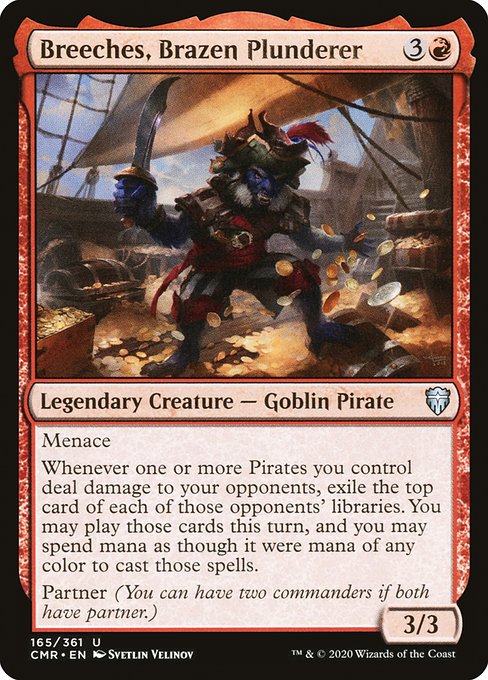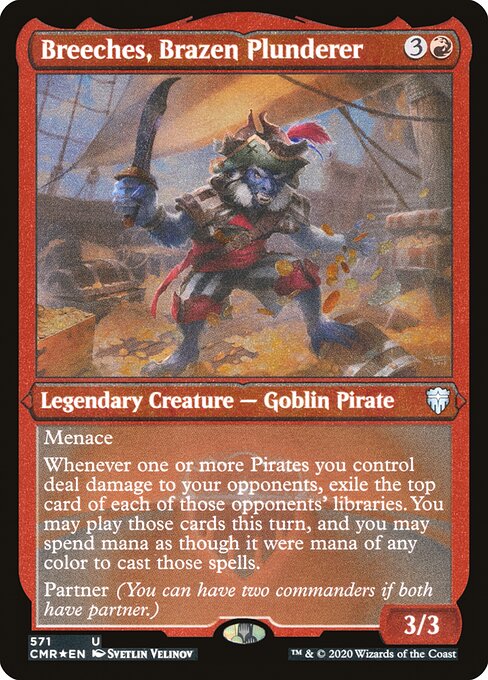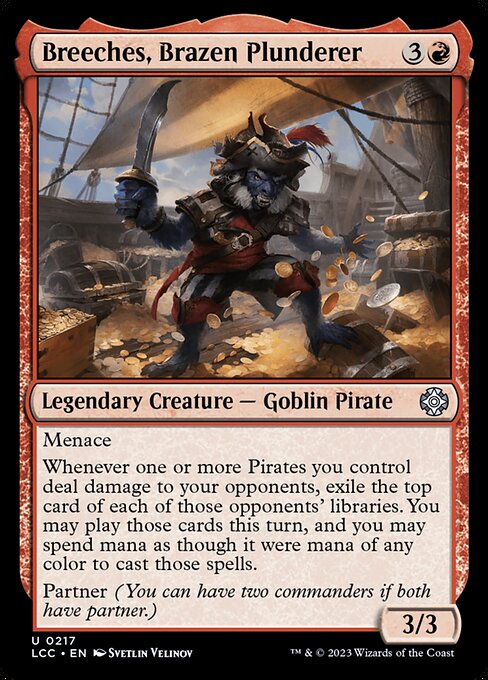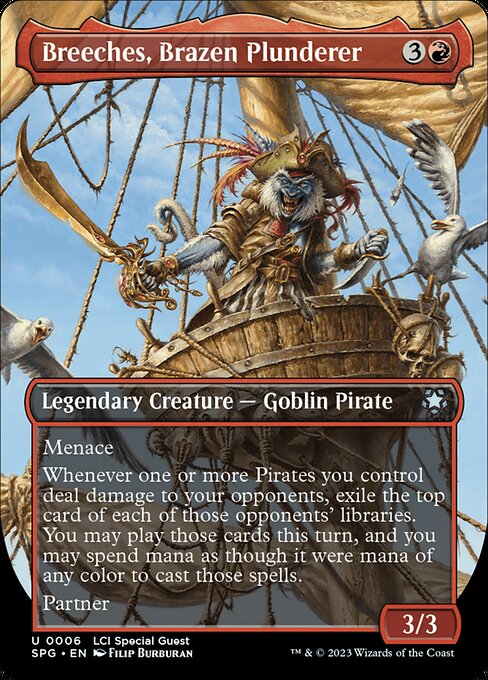Braies, saccageur des hardis
Créature légendaire : gobelin et pirate
Menace
À chaque fois qu'au moins un pirate que vous contrôlez inflige des blessures à vos adversaires, exilez la carte du dessus de la bibliothèque de chacun de ces adversaires. Vous pouvez jouer ces cartes ce tour-ci, et vous pouvez dépenser du mana comme s'il s'agissait de mana de n'importe quelle couleur pour lancer ces sorts.
Partenariat (Vous pouvez avoir deux commandants si les deux ont le partenariat.)
À chaque fois qu'au moins un pirate que vous contrôlez inflige des blessures à vos adversaires, exilez la carte du dessus de la bibliothèque de chacun de ces adversaires. Vous pouvez jouer ces cartes ce tour-ci, et vous pouvez dépenser du mana comme s'il s'agissait de mana de n'importe quelle couleur pour lancer ces sorts.
Partenariat (Vous pouvez avoir deux commandants si les deux ont le partenariat.)
3/3
standard
future
historic
gladiator
pioneer
explorer
modern
legacy
pauper
vintage
penny
commander
brawl
alchemy
paupercommander
duel
oldschool
premodern
Rulings
Both commanders start in the command zone, and the remaining 98 cards (or 58 cards in a Commander Draft game) of your deck are shuffled to become your library.
You’ll still pay all costs for a spell cast this way, including additional costs. You may also pay alternative costs if any are available.
You’ll exile a card from each opponent who was dealt damage, not from all of your opponents.
You can choose two commanders with partner that are the same color or colors. In Commander Draft, you can even choose two of the same commander with partner if you drafted them. If you do this, make sure you keep the number of times you’ve cast each from the command zone clear for “commander tax” purposes.
If your Commander deck has two commanders, you can only include cards whose own color identities are also found in your commanders’ combined color identities. If Falthis and Kediss are your commanders, your deck may contain cards with black and/or red in their color identity, but not cards with green, white, or blue.
You must follow the normal timing permissions and restrictions for each exiled card. If one is a land, you can’t play it unless you have land plays available.
An effect that checks whether you control your commander is satisfied if you control one or both of your two commanders.
To have two commanders, both must have the partner ability as the game begins. Losing the ability during the game doesn’t cause either to cease to be your commander.
In a multiplayer game, if a player leaves the game, all cards that player owns leave as well. If you leave the game, any spells and/or permanents you control from Breeches’s brazen thievery are exiled.
If you don’t play one of the exiled cards, it remains exiled. It won’t be available to be played on future turns.
If something refers to your commander while you have two commanders, it refers to one of them of your choice. If you are instructed to perform an action on your commander (e.g. put it from the command zone into your hand due to Command Beacon), you choose one of your commanders at the time the effect happens.
Once the game begins, your two commanders are tracked separately. If you cast one, you won’t have to pay an additional the first time you cast the other. A player loses the game after having been dealt 21 damage from any one of them, not from both of them combined.
You’ll still pay all costs for a spell cast this way, including additional costs. You may also pay alternative costs if any are available.
You’ll exile a card from each opponent who was dealt damage, not from all of your opponents.
You can choose two commanders with partner that are the same color or colors. In Commander Draft, you can even choose two of the same commander with partner if you drafted them. If you do this, make sure you keep the number of times you’ve cast each from the command zone clear for “commander tax” purposes.
If your Commander deck has two commanders, you can only include cards whose own color identities are also found in your commanders’ combined color identities. If Falthis and Kediss are your commanders, your deck may contain cards with black and/or red in their color identity, but not cards with green, white, or blue.
You must follow the normal timing permissions and restrictions for each exiled card. If one is a land, you can’t play it unless you have land plays available.
An effect that checks whether you control your commander is satisfied if you control one or both of your two commanders.
To have two commanders, both must have the partner ability as the game begins. Losing the ability during the game doesn’t cause either to cease to be your commander.
In a multiplayer game, if a player leaves the game, all cards that player owns leave as well. If you leave the game, any spells and/or permanents you control from Breeches’s brazen thievery are exiled.
If you don’t play one of the exiled cards, it remains exiled. It won’t be available to be played on future turns.
If something refers to your commander while you have two commanders, it refers to one of them of your choice. If you are instructed to perform an action on your commander (e.g. put it from the command zone into your hand due to Command Beacon), you choose one of your commanders at the time the effect happens.
Once the game begins, your two commanders are tracked separately. If you cast one, you won’t have to pay an additional the first time you cast the other. A player loses the game after having been dealt 21 damage from any one of them, not from both of them combined.
Rulings
Both commanders start in the command zone, and the remaining 98 cards (or 58 cards in a Commander Draft game) of your deck are shuffled to become your library.
You’ll still pay all costs for a spell cast this way, including additional costs. You may also pay alternative costs if any are available.
You’ll exile a card from each opponent who was dealt damage, not from all of your opponents.
You can choose two commanders with partner that are the same color or colors. In Commander Draft, you can even choose two of the same commander with partner if you drafted them. If you do this, make sure you keep the number of times you’ve cast each from the command zone clear for “commander tax” purposes.
If your Commander deck has two commanders, you can only include cards whose own color identities are also found in your commanders’ combined color identities. If Falthis and Kediss are your commanders, your deck may contain cards with black and/or red in their color identity, but not cards with green, white, or blue.
You must follow the normal timing permissions and restrictions for each exiled card. If one is a land, you can’t play it unless you have land plays available.
An effect that checks whether you control your commander is satisfied if you control one or both of your two commanders.
To have two commanders, both must have the partner ability as the game begins. Losing the ability during the game doesn’t cause either to cease to be your commander.
In a multiplayer game, if a player leaves the game, all cards that player owns leave as well. If you leave the game, any spells and/or permanents you control from Breeches’s brazen thievery are exiled.
If you don’t play one of the exiled cards, it remains exiled. It won’t be available to be played on future turns.
If something refers to your commander while you have two commanders, it refers to one of them of your choice. If you are instructed to perform an action on your commander (e.g. put it from the command zone into your hand due to Command Beacon), you choose one of your commanders at the time the effect happens.
Once the game begins, your two commanders are tracked separately. If you cast one, you won’t have to pay an additional the first time you cast the other. A player loses the game after having been dealt 21 damage from any one of them, not from both of them combined.
You’ll still pay all costs for a spell cast this way, including additional costs. You may also pay alternative costs if any are available.
You’ll exile a card from each opponent who was dealt damage, not from all of your opponents.
You can choose two commanders with partner that are the same color or colors. In Commander Draft, you can even choose two of the same commander with partner if you drafted them. If you do this, make sure you keep the number of times you’ve cast each from the command zone clear for “commander tax” purposes.
If your Commander deck has two commanders, you can only include cards whose own color identities are also found in your commanders’ combined color identities. If Falthis and Kediss are your commanders, your deck may contain cards with black and/or red in their color identity, but not cards with green, white, or blue.
You must follow the normal timing permissions and restrictions for each exiled card. If one is a land, you can’t play it unless you have land plays available.
An effect that checks whether you control your commander is satisfied if you control one or both of your two commanders.
To have two commanders, both must have the partner ability as the game begins. Losing the ability during the game doesn’t cause either to cease to be your commander.
In a multiplayer game, if a player leaves the game, all cards that player owns leave as well. If you leave the game, any spells and/or permanents you control from Breeches’s brazen thievery are exiled.
If you don’t play one of the exiled cards, it remains exiled. It won’t be available to be played on future turns.
If something refers to your commander while you have two commanders, it refers to one of them of your choice. If you are instructed to perform an action on your commander (e.g. put it from the command zone into your hand due to Command Beacon), you choose one of your commanders at the time the effect happens.
Once the game begins, your two commanders are tracked separately. If you cast one, you won’t have to pay an additional the first time you cast the other. A player loses the game after having been dealt 21 damage from any one of them, not from both of them combined.
Votre collection ? vos decks ?
Envie de gérer votre collection et/ou créer des decks ?


 0
0
 0.14€
0.14€


